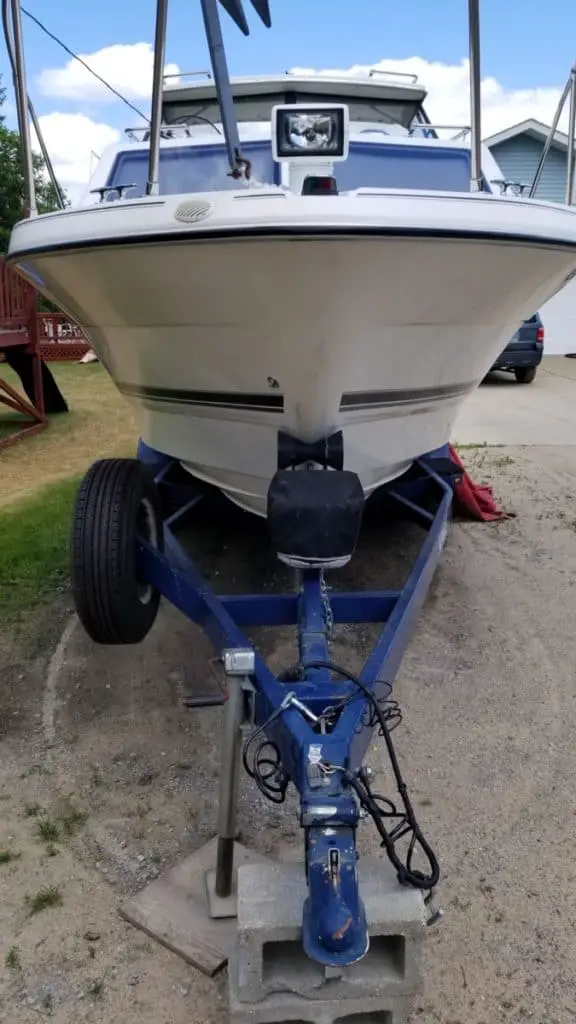Towing a cuddy cabin boat can be an exciting prospect for any boat enthusiast. However, it is crucial to ensure that your vehicle is up to the task.
In my experience, matching the right towing vehicle to your cuddy cabin boat is essential for safe and efficient transportation.
This article aims to provide a comprehensive guide on how to determine if your vehicle can tow a cuddy cabin and what factors to consider, such as boat weight, vehicle towing capacity, and trailer specifications.
Cuddy Cabin Weight
Cuddy cabins come in various sizes and weights, which ultimately influence the type of vehicle required to tow them. To give you a better idea of what to expect, let’s consider the following table, which shows different weight classes of cuddy cabin boats and corresponding vehicles that can tow them:
| Cuddy Cabin Weight | Minimum Vehicle Size Needed | Trailer Type |
|---|---|---|
| Up to 3,500 lbs | Midsize SUVs, Crossovers, Minivans | Single-axle |
| 3,500 – 5,000 lbs | Full-size SUVs, Light Trucks | Single or Tandem-axle |
| 5,000 – 7,000 lbs | Full-size Trucks, Heavy-duty SUVs | Tandem-axle |
| 7,000 lbs and up | Heavy-duty Trucks, Commercial Trucks | Tandem or Triple-axle |
In general, a cuddy cabin will be about 150 pounds in weight per foot of boat (dry weight), and the typical weight range for boats 18-25′ in length is 2,700-3,750 pounds. You can check out my article here that deals with the weights of different types of cuddy cabins.
Before you hitch your cuddy cabin to your vehicle, you need to determine the total weight you will be towing. This is not just the “dry weight” of the cuddy cabin. This includes the weight of the boat, motor, fuel, gear, water, and trailer. From my experience, it’s best to gather this information from the boat and trailer manufacturers.

Vehicle Towing Capacity
Once you have the total weight, compare it to your vehicle’s towing capacity, which you can find in the owner’s manual or on the manufacturer’s website. Keep in mind that the towing capacity should not be exceeded, as this can lead to dangerous driving conditions and potential damage to your vehicle.
In fact, I recommend staying well within your vehicle’s towing capacity for added safety and to account for any additional unexpected weight.
| Vehicle Type | Towing Capacity (lbs) |
|---|---|
| Compact Car (Not Recommended) | 1,000 – 2,500 |
| Midsize Sedan (Not Recommended) | 2,000 – 3,500 |
| Full-size Sedan (Not Recommended) | 3,000 – 5,000 |
| Minivan | 3,500 – 5,000 |
| Small SUV/Crossover | 1,500 – 4,500 |
| Midsize SUV/Crossover | 3,500 – 7,000 |
| Full-size SUV | 6,000 – 9,000 |
| Pickup Truck (1/2 Ton) | 5,000 – 10,000 |
| Pickup Truck (3/4 Ton) | 10,000 – 16,000 |
| Pickup Truck (1 Ton) | 12,000 – 20,000 |
Trailer and Hitch Considerations
When selecting a trailer, consider the number of axles required based on the weight of your cuddy cabin. Single-axle trailers are suitable for lighter boats, while tandem or triple-axle trailers are needed for heavier boats to distribute the weight more evenly and provide better stability. Furthermore, ensure that the trailer is designed for your specific boat to avoid any compatibility issues.
Another important aspect to consider is the hitch size and type . Most cuddy cabin boats require a Class III or Class IV hitch, which can handle between 3,500 and 10,000 lbs of towing weight. However, always double-check the hitch’s weight rating to ensure it matches the total towing weight.
In addition to the weight and towing capacity considerations, it is crucial to account for the impact of wind resistance while driving. Towing a cuddy cabin increases the overall height and width of your vehicle, making it more susceptible to wind. Therefore, it is essential to drive cautiously, especially on windy days or at high speeds.
Final Takeaways
Towing a cuddy cabin is possible with the right vehicle and proper preparation. By determining the total weight of your boat (and gear), selecting an appropriate trailer, and ensuring that your vehicle’s towing capacity is sufficient, you can safely and efficiently transport your cuddy cabin to your desired destination.
Just remember to always follow the manufacturer’s guidelines and exercise caution while driving, especially in challenging weather conditions or on unfamiliar roads. By doing so, you can enjoy countless adventures on the water with your cuddy cabin, knowing that your vehicle is well-equipped to handle the journey.
Happy Boating!

